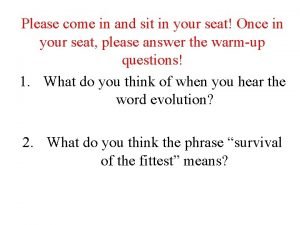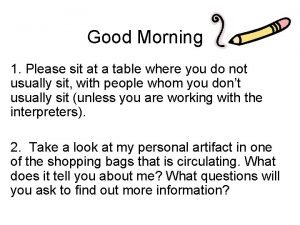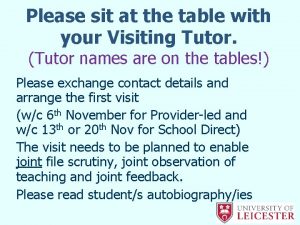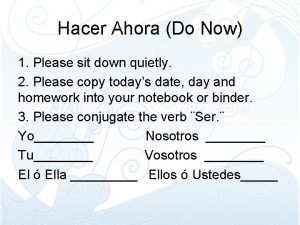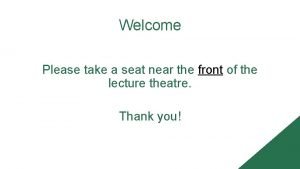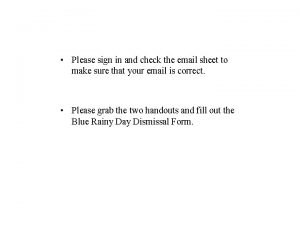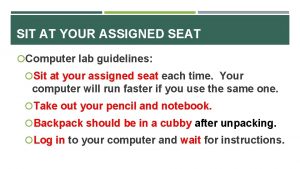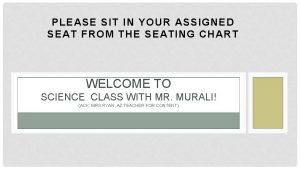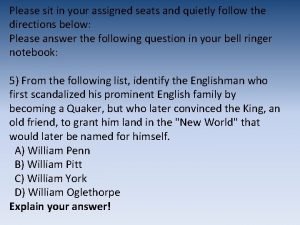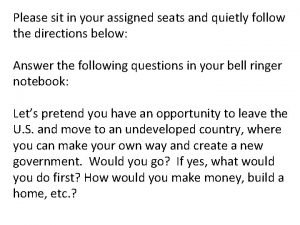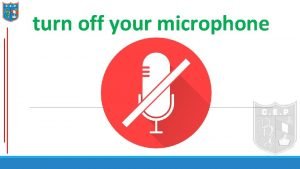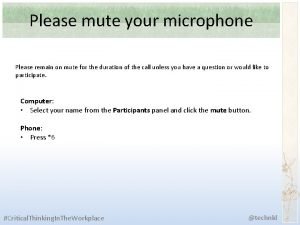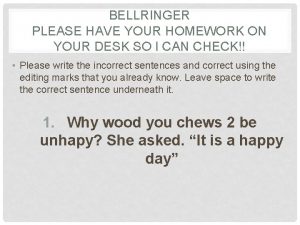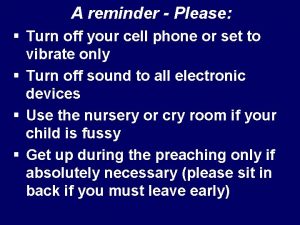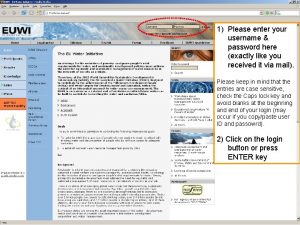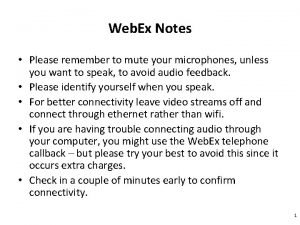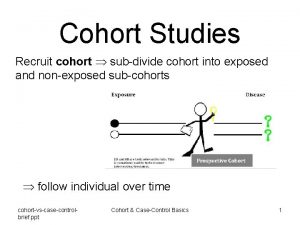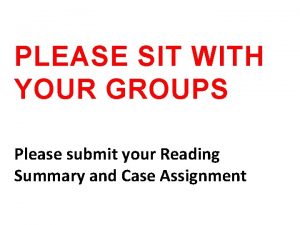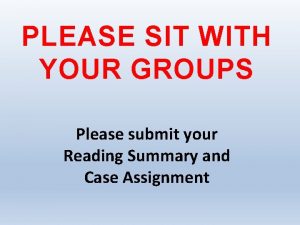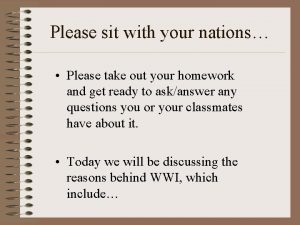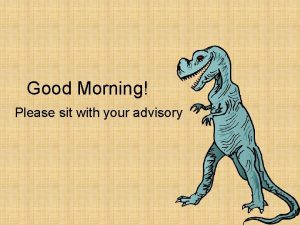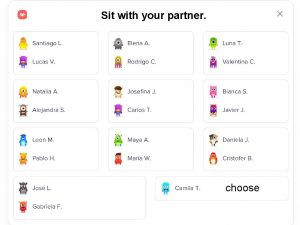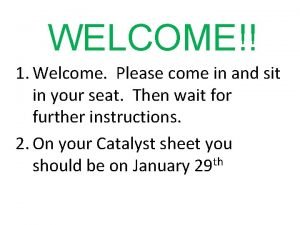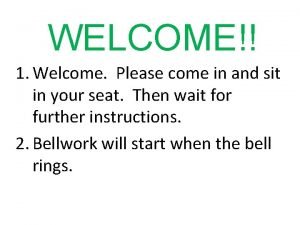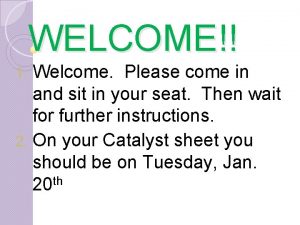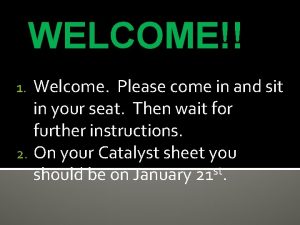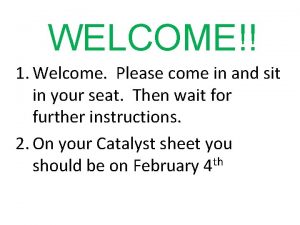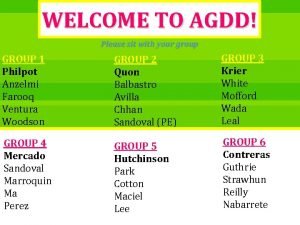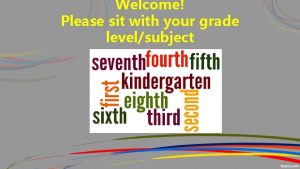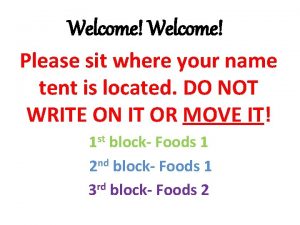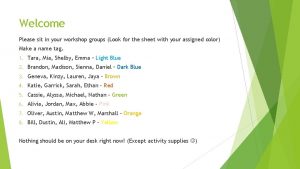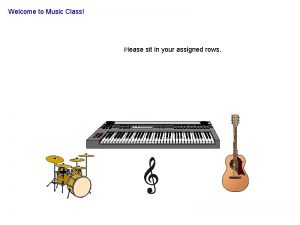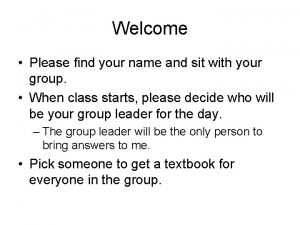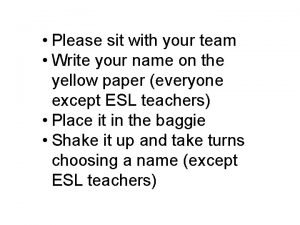History Cohort WELCOME PLEASE SIT WITH YOUR COHORT































- Slides: 31

History Cohort WELCOME. PLEASE SIT WITH YOUR COHORT GROUPS: JFK PATTON LEWIS & CLARK AL CAPONE

The picture riddle below refers to an important event in American history. What does it refer to? THE FIRST PERSON TO YELL IT OUT WINS A PRIZE!

Football & Buckets �Thank you, David! �THINK/PAIR/SHARE #1: Imagine you have elementary aged children. To help them organize their room, you give them several buckets. How do you explain to them how to organize their toys? �THINK/PAIR/SHARE #2: If you are sitting with friends watching a game of football and everyone sees the same game, what are some possible reasons for contention/argument when asked the following question: “Why did ______ win the game? ”

Bucketing the Football DBQ �Your two-fold job: 1. 2. Read through the documents on the football game. Create three or four categories or “buckets” in which to place the documents. Bucket your documents! Be prepared to share the names of your buckets. In one paragraph, answer the DBQ: Why did Sparks win the game over Truckee? Make sure to specifically cite four documents in your answer.

Now that we are warmed up, let’s discuss the question of the moment: In what order do I complete the process of writing my historical background essay and creating and implementing my DBQ? Not an easy question to answer…this is how I would go about the process. Take a minute to review and determine if this works for you.

The DBQ Question What makes a great question? Small groups play with questions… � It is rooted in the big �Get into grade level picture of what you care about kids knowing. � The language of the question specifically explains what it is you want students to do. � No right or wrong answer/evidence on many sides � See “Creating a DBQ” for some examples groups of three. �Talk about your proposed DBQ question. Edit it to be something manageable and clear for your students. �Write your questions on chart paper with room in between each question.

For each step, your group will move to another piece of poster paper and continue to edit and offer suggestions. You should comment on all questions on the poster. �STEP 1/FIRST POSTER: Is the wording of this question clear? Are there multiple ways to answer the question? Can you edit it to make it a better question? �STEP 2/SECOND POSTER: Do you know of any resources that you could share to help this teacher form the DBQ for this question? Do you have any more editing suggestions?

Fun Way to Introduce Your DBQ to Kids �THREE TRUTHS & A LIE: Present true but unknown facts about your topic before you begin teaching. Insert one fact that is false but might be seen as a possible truth. Have students write down their hypothesis as to the lie. This should provoke interest in the subject and make them excited to find out what is true and what is a lie as you teach. �With your group, brainstorm some fun but unknown facts about your subject. Share out the best fact your group came up with.

What do we want students to recognize in every document? �Discuss at your table (and take notes): If you were to create your own document analysis sheet to use with every primary source in your classroom, what would it include? What skill(s) are you valuing with these document analysis questions? How do you get kids to understand that a document is NOT a FACT, but a piece of EVIDENCE to be INTERPRETED.

Creating Great Scaffolding Questions For each document in your DBQ, write down in one sentence what you believe the overarching meaning of the document is. 2. Use questions (moving from LOTS to HOTS). Beyond the information already obtained from your document analysis sheet, create questions that get students to the “heart” of the source. A good formula is 1 -2 LOTS, 2 -3 MOTS, and 1 -2 HOTS 1.

Let’s Practice: Work together in a small, grade level mixed group. What are some questions you might ask for this document? Label your questions at LOTS, MOTS, or HOTS. Boston Globe, May 28, 1898

SOME QUESTIONS MIGHT EVEN BE MULTIPLE CHOICE TO MAKE IT FUN. Which title best describes the message of this cartoon? A: “Neutrality is the best policy. ” B: “Temptations of the Imperialist Menu” C: “Dangers of Overeating” D: “Isolationism: Our Old Ally”

Take some time to read: Creating a DBQ What questions do you have about the process of creating a DBQ? What do you think will be the most difficult part of creating the DBQ? How can we assist you throughout this process?

Student Friendly Vocabulary What does it look like? � Don’t overwhelm students with too many terms. � Write your own definitions that are short and sweet. Do not include any words in the definition that would need defining! � For the terms you do identify: Define them with students Use them yourself regularly Require students to use them in their work Discuss and evaluate context clues Use strategies to reinforce vocabulary acquisition Have a glossary available for primary sources** Practice: Write Student Friendly Definitions �Imperialism �Yellow Journalism �Colonialism

Afternoon Session 1 1: 00 -2: 00 PLEASE HAVE IN FRONT OF YOU Sinking of the Maine DBQ Creation & Implementation: A Think Aloud

Sinking of the Maine DBQ T

Choosing a Topic Sinking of the Maine Media coverage epitomizes “yellow journalism” which is the content under current study Relates to important EQs Relates to current concerns over media driving political dialogue (relevance to big picture) Provides a brief lesson in importance of media literacy, a highly important skill for students Link to Our Topic of Media

Writing the Question Our Question Viable Alternatives? �"The explosion of the �What other questions U. S. S. Maine caused the United States to invade Cuba in 1898. " Use the documents provided and your own knowledge to evaluate this statement. might have worked? �What rationale supports a different question?

Finding Appropriate Documents You get to practice! �There were a plethora of documents on this topic. We have provided you with 13 documents. �In a small group, choose 9 documents to use in the DBQ. Please remember to use… � Documents that present multiple answers to this question; � Documents that 7 th-12 th grade students could understand with proper scaffolding. � Documents that are text based as well as cartoons, pictures, charts or graphs. � Parallel documents (or documents that show different points of view on the same subject) � Documents that have some information (date, author, etc. ) for students to use to place it into context

Choose Documents for the DBQ �Your group can choose no more than 9 documents to use in the DBQ: Evaluate the statement: The explosion of the U. S. S. Maine caused the United States to invade Cuba in 1898. �On the back of each document you choose, write A short description of why your group chose this document. Any questions you have about that document for our historian to answer. �Make a pile of any documents you think are not at all useful for this DBQ.

Share Out What documents did your group choose? Why did you choose them? Do you have any questions for our resident historian?

How would you answer this DBQ? �Now that you have 9 documents for the DBQ, use your buckets to link common information together. �Write two different thesis statements to answer this question. In other words, prove that there is more than one interpretation of this DBQ.

AFTERNOON SESSION 2 CREATING A DBQ, PART II 2: 45 -3: 30

Formatting the DBQ �Please refer to the Sinking of the Maine DBQ we created formatting tips: Question (in the page header) Source Number & Name of Source Vocabulary and Definitions for Document Note – Background Information Document Itself (If necessary for readability, add Document Text and/or Captions. ) 7. Source Information – Date, Author, Publisher, Etc. 8. Scaffolding Questions for Students to Answer 1. 2. 3. 4. 5. 6.

Compiling the DBQ Project �Cover Page DBQ question Contact Information (your name(s) and email address) �Historical Background Essay �Documents (at least six primary documents along with secondary documents; each on a separate page; formatted with the 8 criteria) �Assessment Directions (Assignment Sheet for Students) �Rubric/Grading Criteria � PLEASE CREATE A PDF FOR YOUR DOCUMENT BEFORE EMAILING IT TO US TO MAINTAIN YOUR FORMATTING.

What is “argument” and how do we teach it? �The natural inclination for all students (even in AP) writing a DBQ is to make a list of documents and facts. �An argument takes those facts, puts them together, and demonstrates a way of thinking about their relationship. �The bucket titles become the basis of your argument. �Use one of your group’s buckets about the football game to write an argument about the documents inside. �This would become one of your paragraphs.

A DBQ SHOULD REQUIRE STUDENTS TO… �Analyze information from many sources and synthesize the meaning of that information �Take an informed stance �Write a clear thesis �Argue multiple points using specific evidence �DOING ALL OF THIS WITHIN AN ESSAY IS SUGGESTED, BUT AN ESSAY MAY NOT ALWAYS BE THE BEST ASSESSMENT.

WITH A PARTNER FROM A DIFFERENT GRADE AND A DIFFERENT SCHOOL, BRAINSTORM… What alternative forms of assessment could students use to answer a DBQ?

ASSESSING THE DBQ: Group Discussion �What is the best way to: Know students really learned about the subject? Evaluate if they used evidence to make their arguments? Determine if their thesis is valid? �How can we promote good writing in our assessments? �How can we provide good feedback without killing ourselves? How can we make sure that students use that feedback to better their writing/learning? �What does MEANINGLESS assessment and feedback look like? How can we get away from this?

BRAINSTORM WHAT ARE THE KEY COMPONENTS FOR A RUBRIC ON A DBQ? WHAT DOES A TOP SCORE IN EACH COMPONENT LOOK LIKE? EACH GROUP WILL SHARE OUT THEIR BRAINSTORMING LIST.

PLEASE FILL OUT THE SATISFACTION SURVEY & CHECK YOUR HOURS WITH SUE MEETING/ASSIGNMENT DATE/TIME/LOCATION Saturday Dialogue: Social Change & Film Tomorrow – Nevada Museum of Art of Audubon Thursday, January 13 4: 00 -6: 00, NMA Muckrakers: America’s Dirty Laundry Saturday, January 29 9: 30 -2: 30 Email 6 primary sources and scaffolding questions to Angela Friday, February 18
 Retrospective cohort study vs prospective cohort study
Retrospective cohort study vs prospective cohort study Please sit down and your seat belts
Please sit down and your seat belts Hey hey people
Hey hey people Please sit down and your seat belts
Please sit down and your seat belts Sit ins
Sit ins Please extend your warm welcome
Please extend your warm welcome The count your master's known munificence
The count your master's known munificence Please sit at the table
Please sit at the table Please sit at the table
Please sit at the table Please sit back and relax
Please sit back and relax Please sit down
Please sit down Nobody said anything raymond carver
Nobody said anything raymond carver Welcome please take a seat
Welcome please take a seat Welcome please sign in
Welcome please sign in Sit in your assigned seat
Sit in your assigned seat Sit in your assigned seat
Sit in your assigned seat Sit in your assigned seat
Sit in your assigned seat Sit in your assigned seat
Sit in your assigned seat Wise men three clever are we
Wise men three clever are we Give us your hungry your tired your poor
Give us your hungry your tired your poor Type your answer in the chat box
Type your answer in the chat box Turn off microphone
Turn off microphone Please mute your microphone when not speaking
Please mute your microphone when not speaking Please mute your microphone
Please mute your microphone Toxic polyamory
Toxic polyamory Please mute your microphone
Please mute your microphone Please put your homework my desk
Please put your homework my desk Please turn off your cell phone in church
Please turn off your cell phone in church Please enter username and password
Please enter username and password What does the teacher say to get attention
What does the teacher say to get attention Arrcu
Arrcu Please clean the room before you live
Please clean the room before you live

